1995 GMC SIERRA tire size
[x] Cancel search: tire sizePage 211 of 488
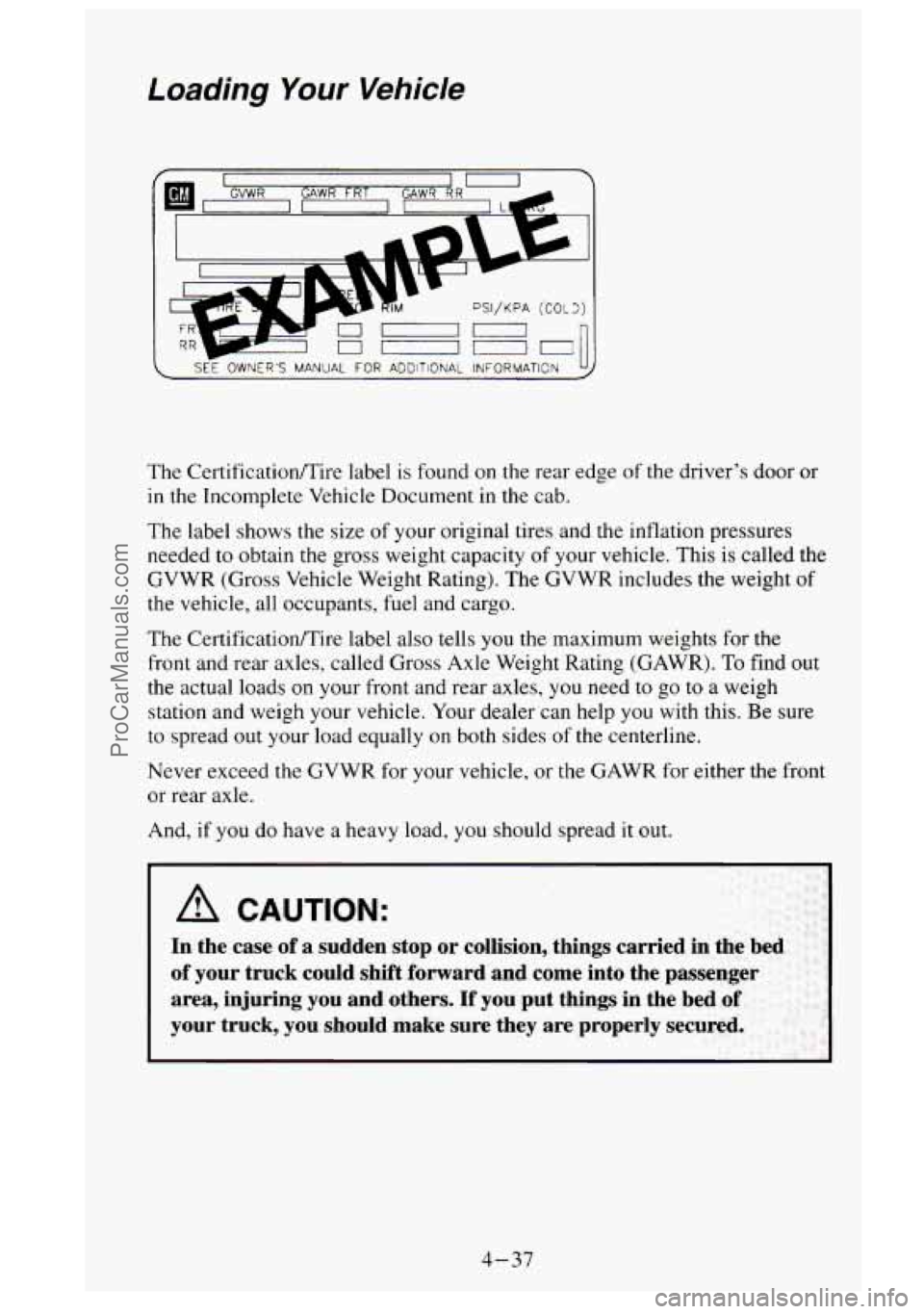
Loading Your Vehicle
-
DSI/KPA (COL3)
The Certification/Tire label is found on the rear edge of the driver’s door or
in the Incomplete Vehicle Document in the cab.
The label shows the size of your original tires and the inflation pressures
needed to obtain
the gross weight capacity of your vehicle. This is called the
GVWR (Gross Vehicle Weight Rating). The
GVWR includes the weight of
the vehicle, all occupants, fuel and cargo.
The CertificatiodTire label also tells you the maximum weights for the
front and rear axles, called Gross Axle Weight Rating (GAWR).
To find out
the actual loads
on your front and rear axles, you need to go to a weigh
station and weigh your vehicle. Your dealer can help
you with this. Be sure
to spread out your load equally on both sides of the centerline.
Never exceed the GVWR for your vehicle, or the GAWR for either the front
or rear axle.
And,
if you do have a heavy load, you should spread it out.
A CAUTION-:
In the case of a sudden stop or collision, things carried in the bed
of your truck could shift forward and come into the passenger \
area, injuring you and
others. If you put things in the bed of
your truck, you
should make sure they are properly secured.
4-37
ProCarManuals.com
Page 219 of 488
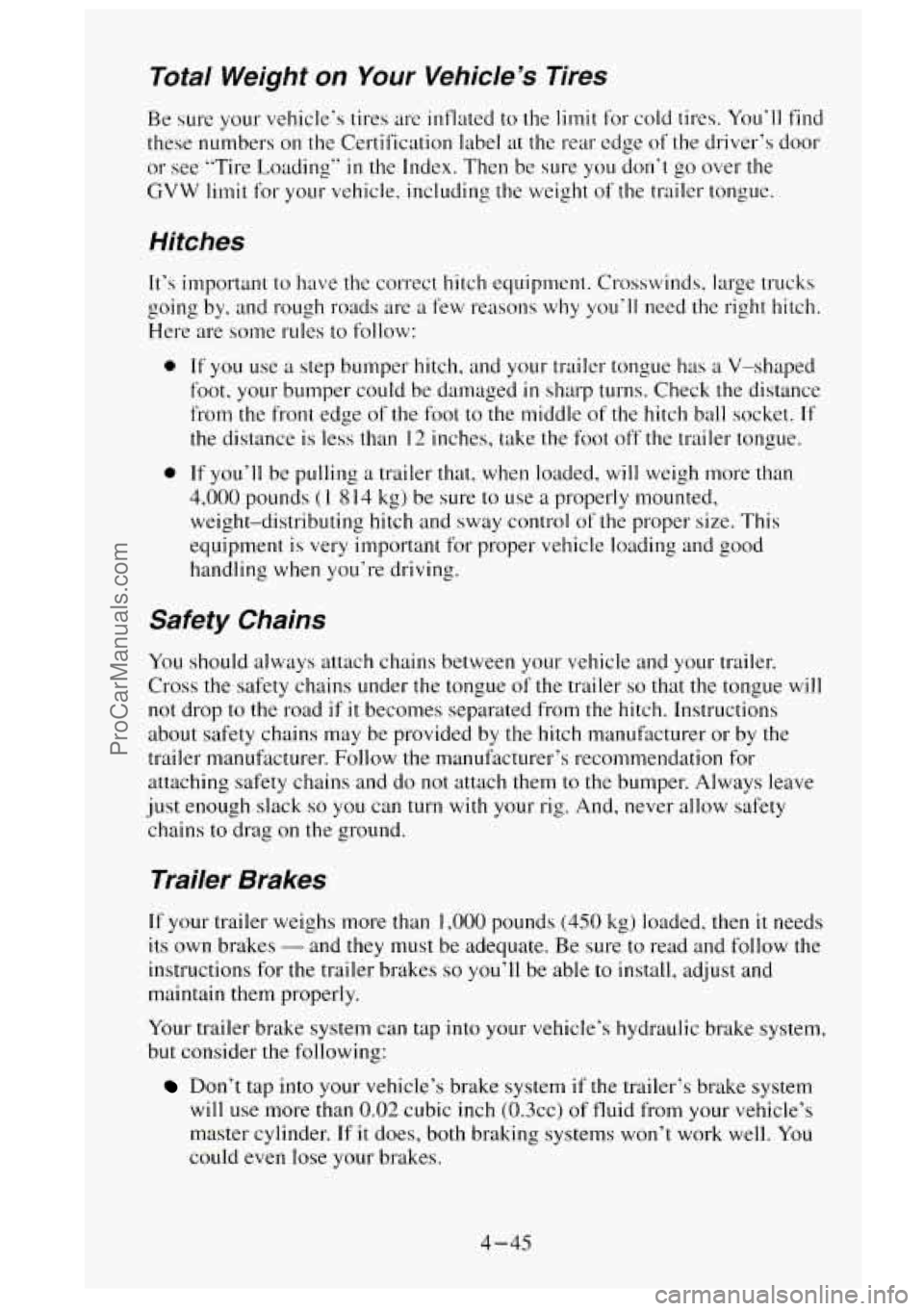
Total Weight on Your Vehicle’s Tires
Be sure your vehicle‘s tires are inflated to the limit for cold tires. You’ll find
these numbers on the Certification label at the rear
edge of the driver’s door
or see “Tire Loading“
in the Index. Then be sure you don‘t go over the
GVW limit for your vehicle, includins the weight of the trailer tongue.
Hitches
It’s important to have the correct hitch equipment. Crosswinds, large trucks
going by, and rough roads are
a few reasons why you’ll need the right hitch.
Here are some rules to follow:
e
e
If you use a step bumper hitch, and your trailer tongue has a V-shaped
foot. your bumper could be damaged
in sharp turns. Check the distance
from the front edge
of the foot to the middle of the hitch ball socket. If
the distance is less than 12 inches, take the foot off the trailer tongue.
If you‘ll be pulling a trailer that, when loaded,
will weigh more than
4,000 pounds
( 1 8 14 kg) be sure to use a properly mounted,
weight-distributing hitch and sway control
of the proper size. This
equipment is very important for proper vehicle loading and good
handling when you’re driving.
Safety Chains
You should always attach chains between your vehicle and your trailer.
Cross the safety chains under the tongue
of the trailer so that the tongue will
not drop to the road if it becomes separated from the hitch. Instructions
about safety chains may be provided by the hitch manufacturer or by the
trailer manufacturer. Follow the manufacturer’s recommendation for
attaching safety chains and do not attach them to the bumper. Always leave
just enough slack
so you can turn with your rig. And, never allow safety
chains to drag on the ground.
Trailer Brakes
If your trailer weighs more than 1,000 pounds (450 kg) loaded, then it needs
its own brakes
- and they must be adequate. Be sure to read and follow the
instructions for the trailer brakes
so you’ll be able to install. adjust and
maintain them properly.
Your trailer brake system can tap into your vehicle’s hydraulic brake system,
but consider the following:
Don’t tap into your vehicle’s brake system if the trailer’s brake system
will use more than 0.02 cubic inch (0.3~~)
of fluid from your vehicle’s
master cylinder.
Tf it does, both braking systems won’t work well. You
could even lose your brakes.
4-45
ProCarManuals.com
Page 252 of 488
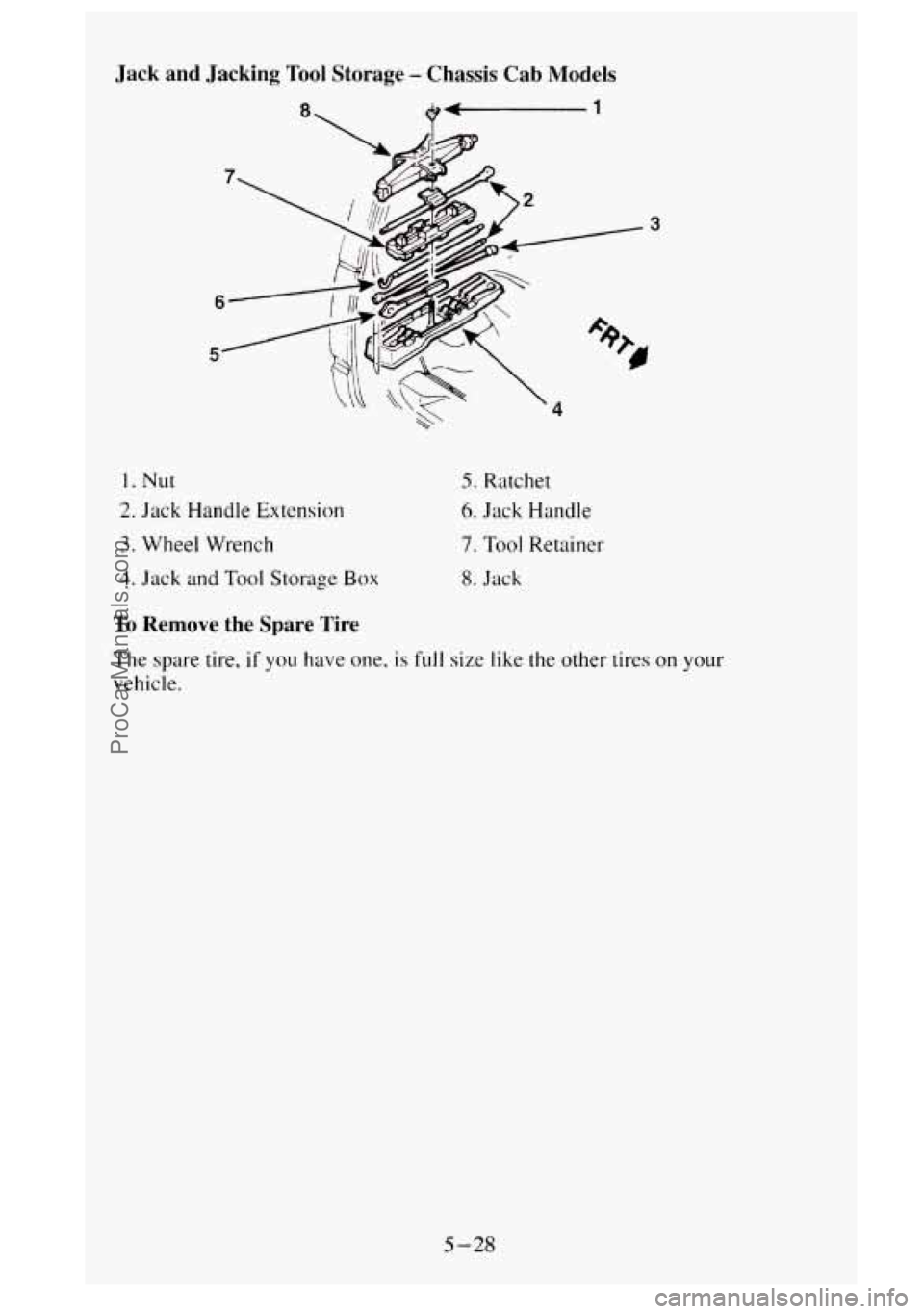
Jack and Jacking Tool Storage - Chassis Cab Models
a -1
Jacking Tool Storage - Chassis Cab Models
a -1
3
3
1. Nut
2. Jack Handle Extension
3. Wheel Wrench
4. Jack and Tool Storage Box
5. Ratchet
6. Jack Handle
7. Tool Retainer
8, Jack
To Remove the Spare Tire
The spare tire, if you have one, is full size like the other tires on your
vehicle.
5-28
ProCarManuals.com
Page 328 of 488
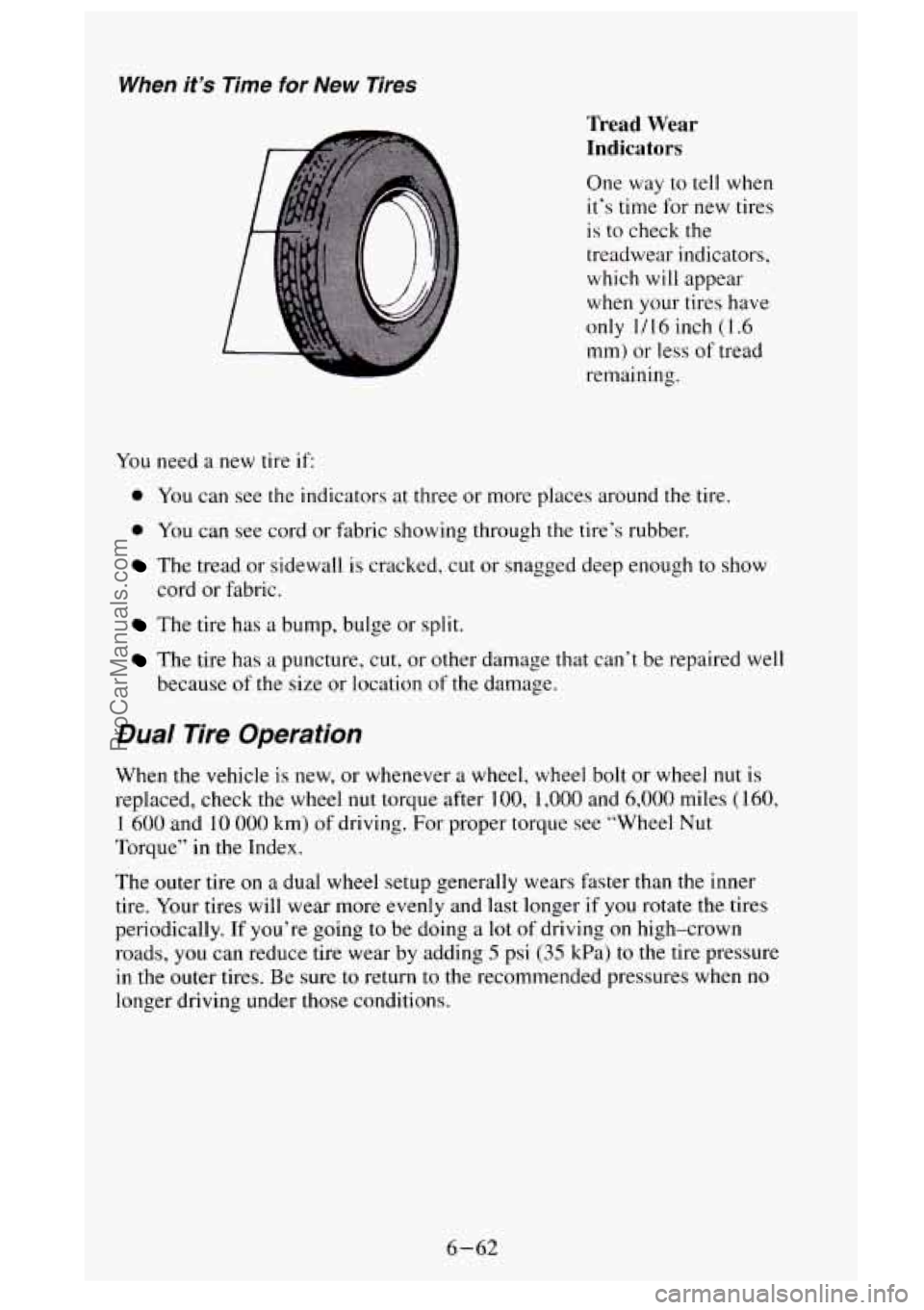
When it’s Time for New Tires
You need a new tire if:
Tread Wear
Indicators
One way to tell when
it’s time for new tires
is to check the
treadwear indicators,
which will appear
when your tires have
only
1/16 inch (1.6
mm)
or less of tread
remaining.
0 You can see the indicators at three or more places around the tire.
0 You can see cord or fabric showing through the tire’s rubber.
The tread or sidewall is cracked, cut or snagged deep enough to show
cord
or fabric.
The tire has a bump, bulge or split.
The tire has a puncture, cut, or other damage that can‘t be repaired well
because
of the size or location of the damage.
Dual Tire Operation
When the vehicle is new, or whenever a wheel, wheel bolt or wheel nut is
replaced, check the wheel
nut torque after 100, 1,000 and 6,000 miles (160,
1 600 and 10 000 km) of driving. For proper torque see “Wheel Nut
Torque” in the Index.
The outer tire
on a dual wheel setup generally wears faster than the inner
tire. Your tires will wear more evenly and last longer
if you rotate the tires
periodically. If you’re going to be doing
a lot of driving on high-crown
roads, you can reduce tire wear by adding
5 psi (35 kPa) to the tire pressure
in the outer tires. Be sure to return
to the recommended pressures when no
longer driving under those conditions.
6-62
ProCarManuals.com
Page 329 of 488
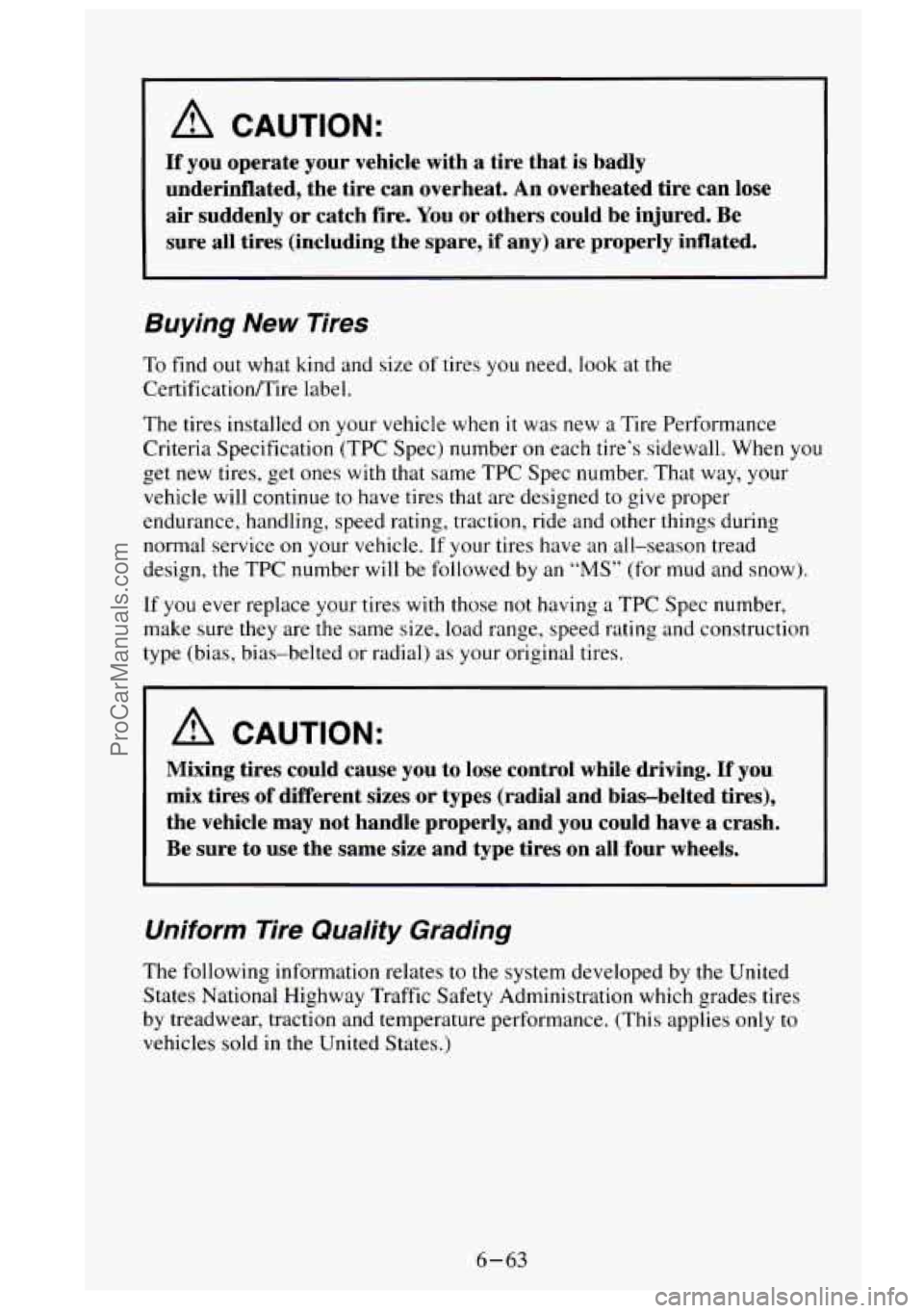
A CAUTION:
If you operate your vehicle with a tire that is badly
underinflated, the tire can overheat. An overheated tire
can lose
air suddenly or catch fire. You or others could be injured. Be
sure all tires (including the spare, if any) are properly inflated.
Buying New Tires
To find out what kind and size of tires you need, look at the
CertificationRire label.
The tires installed on your vehicle when
it was new a Tire Performance
Criteria Specification (TPC Spec) number on each tire’s sidewall. When you
get new tires, get ones with that same TPC Spec number. That way, your
vehicle will continue to have tires that are designed to give proper
endurance, handling, speed rating, traction, ride and other things during
normal service on your vehicle.
If your tires have an all-season tread
design, the TPC number will be followed by an
“MS” (for mud and snow).
If you ever replace your tires with those not having a TPC Spec number,
make sure they are the same. size, load range, speed rating and construction
type (bias, bias-belted or radial) as your original tires.
I A CAUTION:
Mixing tires could cause you to lose control while driving. If you
mix tires of different sizes or types (radial and bias-belted tires),
the vehicle may not handle properly, and you could have
a crash.
Be sure to use the same size and type tires on all four wheels.
Uniform Tire Quality Grading
The following information relates to the system developed by the United
States National Highway Traffic Safety Administration which grades tires
by treadwear, traction and temperature performance.
(This applies only to
vehicles sold in the United States.)
6-63
ProCarManuals.com
Page 332 of 488
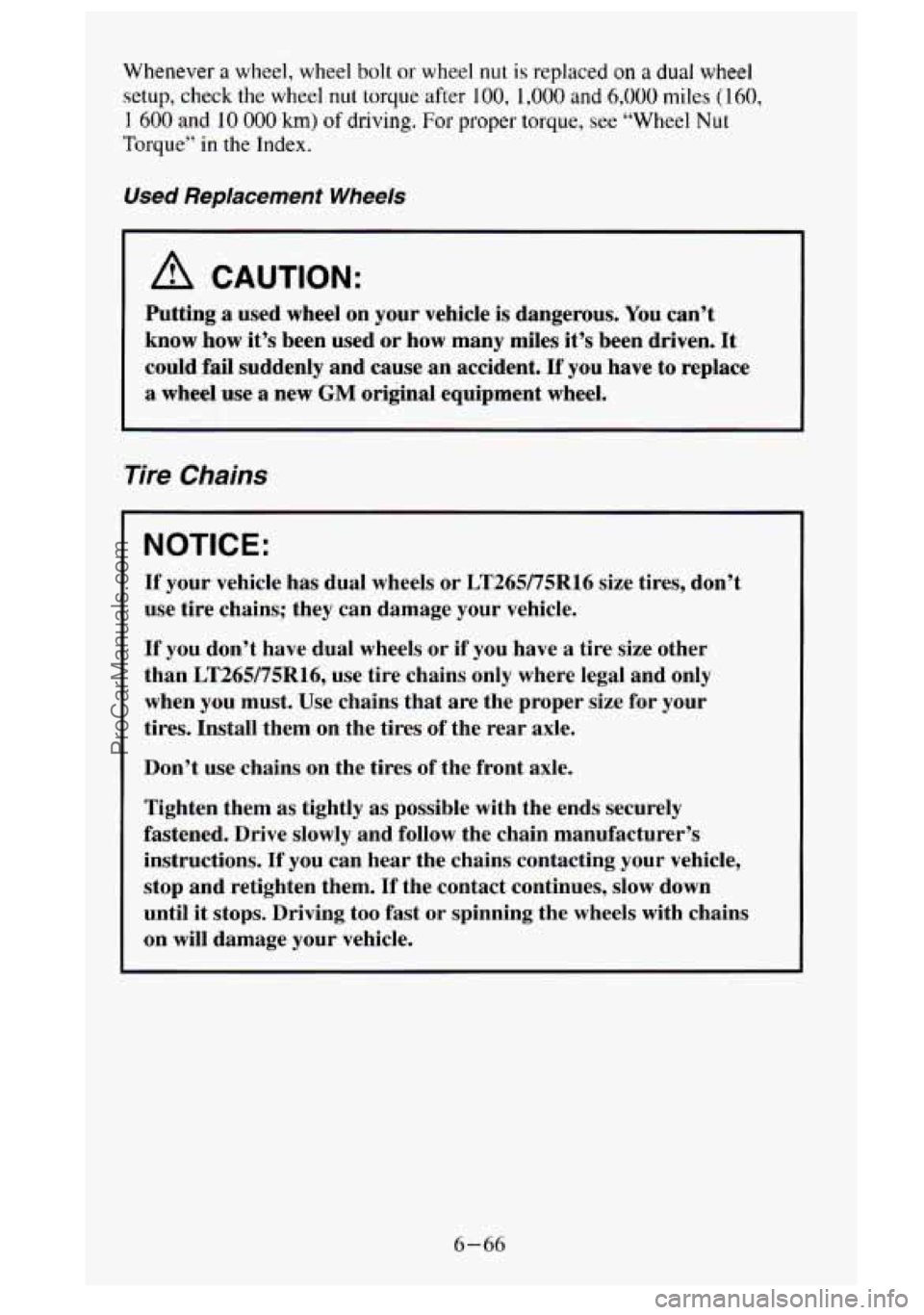
Whenever a wheel, wheel bolt or wheel nut is replaced on a dual wheel
setup, check the wheel nut torque after 100, 1,000 and 6,000 miles ( 160,
1 600 and 10 000 km) of driving. For proper torque, see “Wheel Nut
Torque” in the Index.
Used Replacement Wheels
A CAUTION:
Putting a used wheel on your vehicle is dangerous. You can’t
know
how it’s been used or how many miles it’s been driven. It
could fail suddenly and cause an accident. If you have to replace
a wheel use a new GM original equipment wheel.
7
c
‘ire Chains
NOTICE:
If your vehicle has dual wheels or LT265/75R16 size tires, don’t
use tire chains; they can damage your vehicle.
If you don’t have dual wheels or if you have a tire size other
than
LT26975R16, use tire chains only where legal and only
when you must. Use chains that are the proper size for your
tires. Install them on the tires of the rear axle.
Don’t use chains on the tires
of the front axle.
Tighten them
as tightly as possible with the ends securely
fastened. Drive slowly and follow the chain manufacturer’s
instructions. If you can hear the chains contacting your vehicle,
stop and retighten them. If the contact continues, slow down
until it stops. Driving too fast
or spinning the wheels with chains
on
will damage your vehicle.
6-66
ProCarManuals.com
Page 341 of 488
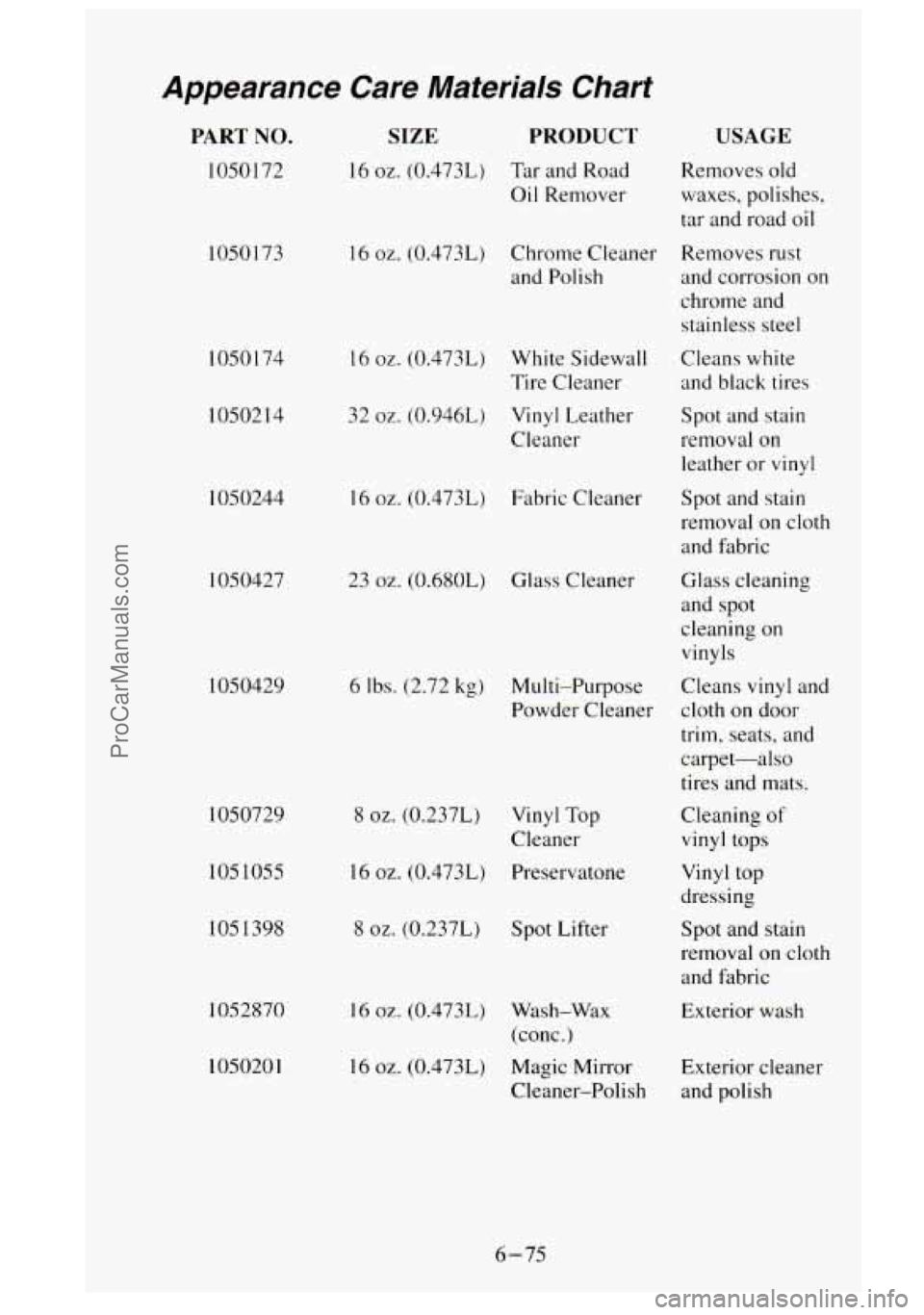
Appearance Care Materials Chart
PART NO.
1050172 1050173
1050 174 10502
14
1050244
1050427
1050429
1050729
1051055 1051398
1052870 105020
1
SIZE
16 oz. (0.473L)
16
oz. (0.473L)
16
oz. (0.473L)
32
oz. (0.946L)
16 oz. (0.473L)
23
oz. (0.680L)
6 Ibs. (2.72
kg)
8 oz. (0.237L)
16 oz. (0.473L)
8 oz. (0.237L)
16 oz. (0.473L)
16 oz. (0.473L)
PRODUCT
Tar and Road
Oil Remover
USAGE
Removes old
waxes, polishes,
tar and road oil
Chrome Cleaner Removes
rust
and Polish and corrosion on
chrome
and
stainless steel
White Sidewall
Tire Cleaner
Vinyl Leather
Cleaner
Fabric Cleaner
Glass Cleaner
Multi-Purpose
Powder Cleaner
Vinyl Top
Cleaner
Preservatone
Spot Lifter
Wash-Wax (conc
.)
Magic Mirror
Cleaner-Polish Cleans
white
and black tires
Spot
and stain
removal on
leather or
vinyl
Spot and stain
removal on cloth and fabric
Glass cleaning
and spot
cleaning on
vinyls
Cleans
vinyl and
cloth on door
trim, seats, and
carpet-also tires and mats.
Cleaning
of
vinyl tops
Vinyl top
dressing
Spot and stain
removal on cloth
and fabric
Exterior wash
Exterior cleaner
and polish
6-75
ProCarManuals.com